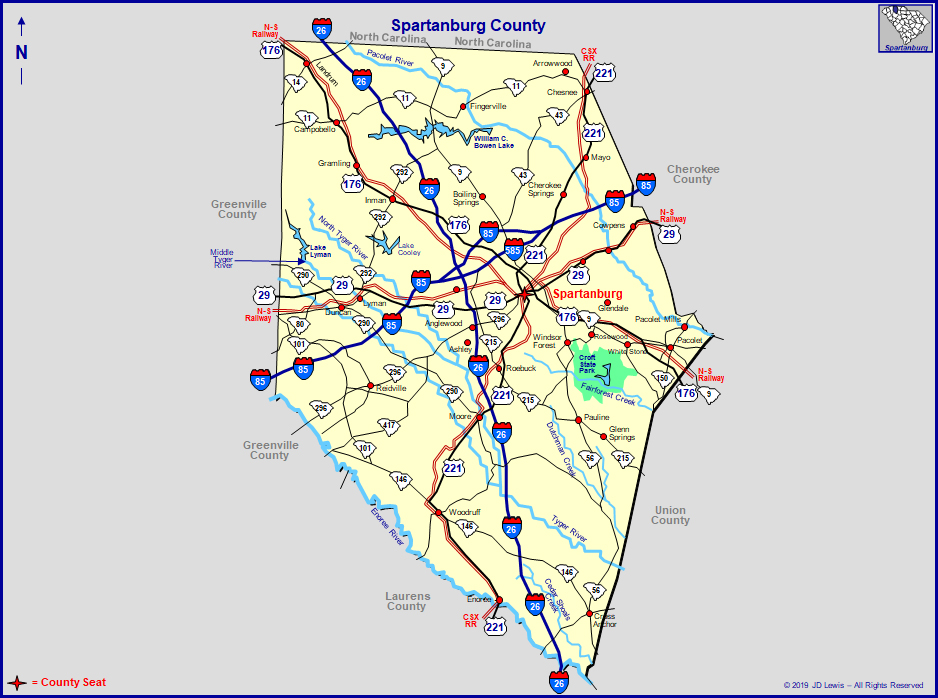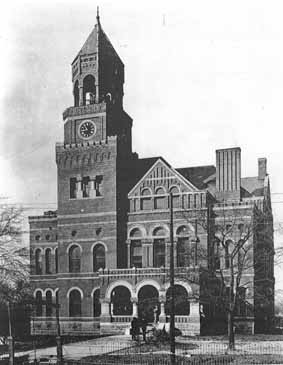 |
||||
|
|
||||
|
|
|
|
|
|
|
|
|
|
|
|
|
|
|
|
|
|
|
|

|
|
|
|
|
|
|
|
|
|
|
|
|
|
|
|
|
|
|
|
|
|
|||
 Spartanburg County Court House - Spartanburg, South Carolina Spartanburg County and its county seat, the city of Spartanburg, were named for the Spartan Regiment, a local militia regiment that fought in the American Revolutionary War. As Spartan County, it was formed in 1785 as a part of the Ninety-Six District. In 1791, it was renamed to Spartanburg County, and from 1791 to 1800 it was part of the Pinckney District. Much later, in 1897, part of Spartanburg County went to form Cherokee County. In 1800, all "over-arching Districts" were abolished, and all counties were renamed as districts, including the Spartanburg District. In 1868, South Carolina redefined all districts back to counties, and Spartanburg County has continued to this day. European settlers, primarily Scots-Irish, began moving into this area from Pennsylvania and Virginia in the latter half of the eighteenth century. For many years the primary occupations were small-scale cattle raising and cotton farming. Areas with mineral springs, such as Glenn Springs, were also popular summer resorts for lowcountry residents. Following the American Civil War, textile manufacturing became the dominant industry, and Spartanburg County remains an important manufacturing center today. Some well known Spartanburg residents are hymn writer and publisher William Walker (1809-1875), Army general William C. Westmoreland, and industrialist Roger Milliken. The upcountry of South Carolina, which includes Spartanburg County, was ceded to the English by the Cherokee Indians in 1755. Spartanburg was the frontier next to the Cherokee Nation. Among the earliest settlers in Spartanburg County were the Scots-Irish immigrants from Pennsylvania, the Indian traders, and the cowmen. At first, they lived in peace with the Cherokee Indians, but during the Indian Wars, they lived in fear and built several forts, including Fort Prince, Gowen’s Fort, and Fort Nichols. In 1776, the present-day Greenville County-Spartanburg County boundary was established to separate white man’s territory from the Cherokee nation. The old Spartan County was a hotbed of action during the American Revolutionary War, including a bloody civil war between Loyalists and Patriots. The Battle of Cowpens on January 17, 1781 was a pivotal battle of the Revolution in which the Americans were led by Brigadier General Daniel Morgan whose military strategy is still admired today. Cowpens is now in Cherokee County. A monument to Morgan stands in the city’s square. Following the organization of the United States, the economy in Spartanburg District turned to cotton and the development of textile mills drawing on the abundant water power in the piedmont. Most farms were small and not as dependent on slave labor as the huge plantations in South Carolina’s lowcountry. While South Carolina led the way in secession from the United States and many South Carolina and Spartanburg men served in the Confederate forces, there were no major battles of the American Civil War fought in the county. Union General William Tecumseh Sherman’s devastating march to the sea ruined much of the state but bypassed Spartanburg, although the area shared in the general deprivation of the war. However, by the 1880s, Spartanburg County was booming due in large part to the rapidly expanding textile industry. The town grew quickly with many moving into mill villages to staff the mills. Spartanburg prided itself on its commercial acumen and cultural advances. The county had been an educational center from its beginning. Wofford and Converse colleges, large residences, a public library and an Opera House known throughout the South for its musical offerings provided a strong sense of pride in the city. With the construction of several rail lines passing through the city, the state’s first municipal airport, several mineral springs resorts within the county, a busy agricultural center and the ever-present textile mills, Spartanburg was "the Hub of the Piedmont." The area’s mild climate and hard-charging businessmen attracted one of the largest troop-training facilities for World War I to the area. In 1917, Camp Wadsworth opened on the western edge of the city. Click Here to view a map showing Camp Wadsworth. The 1929 stock market crash, the subsequent prolonged closing of all banks in the county, and the national depression hit Spartanburg County hard. The area revived at the beginning of the second World War. Another large troop-training facility, Camp Croft, brought hundreds of thousands of soldiers through the county. Peach growing made Spartanburg a top producer of the crop and the textile industry benefited from war-time demands. After World War II, Spartanburg County's industry slowly began to diversify and today the county is home to many types of industries. During the late 1950s and early 1960s, the county became a center of foreign industry when many European companies located plants and offices here. Today the county is a home to many Asian companies as well. The Greenville-Spartanburg Airport has recently expanded to handle increasing commercial traffic and there are several foreign trade zones located here. Today the city is home to five colleges, Milliken Research Center, BMW, Michelin, Hoechst Celanese, and many other businesses. Interstates 85 and 26 criss-cross the area. Spartanburg is an active center of the arts and its downtown is booming once again with restaurants, shops, and a new library. A major shopping mall and the proximity to neighboring Greenville has brought expansive growth to the west side of Spartanburg County. Recreational opportunities include boating and fishing on Lake Bowen and Lake Blalock, the bicycling Assault on Mount Mitchell, an extensive youth soccer program, a nationally known youth swimming program, and easy access to the nearby mountains. Hardy Scots-Irish pioneers blazing their trail into the northwestern section of South Carolina a century and a half ago, thinking, perhaps, of the type of manhood most admired in those times, christened the region they settled "Spartanburg," and in 1791 Spartanburg County was organized. Today, Spartanburg County is peopled by prosperous descendants of these trail blazers. The population in 1920 was 94,265, estimated for 1925 at 100,382. Three years ago the county achieved the distinction of being ranked twenty-eighth among the 3,069 counties of the United States in value of agricultural products. Spartanburg County is first in population to the square mile and second in total population of South Carolina counties. It ranks first among South Carolina counties in white, American-born population, in rural population, in value of manufactured products, in value of agricultural products, and in number of looms and spindles. The county contains 765 square miles of lands unsurpassed for fertility in the Southeast. Of the 489,600 acres, 39.9 per cent is Cecil sandy clay loam, and 32.2 is Cecil sandy loam. The growing season is 210 days, and the rainfall ranges from 45 to 50 inches. Practically all of the county is more than 875 feet above sealevel. Farm products in 1925 were valued at more than $15,000,000. Two agricultural agents are employed. Of crops that flourish are alfalfa, asparagus, cabbage, watermelons, carrots, clover, grass mixtures for hay, cucumbers, peas, beans, corn, wheat, oats, rye, peanuts, sorghum, soy beans, spinach, strawberries, sweet potatoes, and velvet beans. Prosperous orchards dot the gentle slopes of the county, many carloads of peaches and apples are shipped annually, and dozens of young orchards are nearing maturity. Four railroads (mileage 126) cross the county, which is linked with the three great railroads serving the South - the Southern Railway, the Atlantic Coast Line Railroad, the Seaboard Air Line Railway - plus the Clinchfield Railroad - rendering vast markets easily accessible to both farmers and manufacturers. Spartanburg County is covered with a network of power transmission lines, totaling 250 miles. Four power companies operate within the county. Many hundreds of thousands of dollars have been invested in Spartanburg County by New Englanders. Local and outside capital has built cotton mills, operating 25,000 looms and 950,000 spindles. Thirty-five million dollars is invested in the plants, which produce an annual output valued at $40,000,000. The picture is of a typical home of a textile mill worker is Percolate village. Iron and steel fabricating plants, railway repair shops, machine shops, oil mills, fertilizer plants, lumber mills, cement pipe, creosoting, and many other industrial enterprises flourish. The annual output of eight cottonseed oil mills is valued at more than $1,000,000. Thirty prosperous banks and seven building and loan associations contribute to prosperity. There are more than 70 churches in the county, and 104 public schools, of which 19 are high schools. Wofford College, for young men, and Converse College, for young women, are in Spartanburg city. The South Carolina School for the Deaf and the Blind is in Spartanburg County. Along the excellent highways traversing the county are attractive and substantial farm homes. Lighted with electricity, many of these rural homes are equipped with waterworks and most of the other conveniences to be found in urban residences. Spartanburg is rich in history. Congress now has under consideration a bill to convert into a national military park the Cowpens battleground, where the British Lt. Colonel Banastre Tarleton was repulsed by Brigadier General Daniel Morgan and his riflemen. Other spots made famous in the Revolutionary or Confederate wars are in the county. Immediately above, published in "South Carolina: A Handbook," prepared by The Department of Agriculture, Commerce, and Industries and Clemson College, Columbia, South Carolina, 1927. In the Public Domain. [with minor edits] |
|||
 |
 |
© 2021 - J.D. Lewis - PO Box 1188 - Little River, SC 29566 - All Rights Reserved